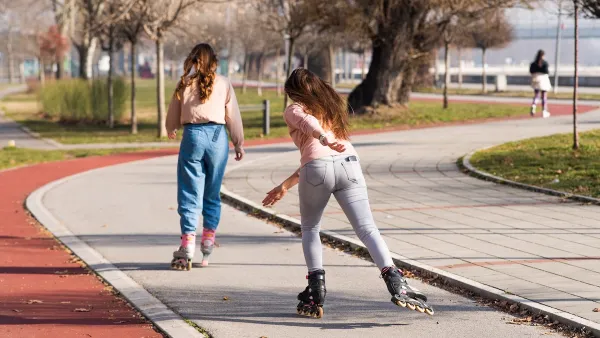Should Segways be allowed on sidewalks? Should all bicycles travel only in designated bike lanes? Should motorized scooters be treated as if they are wheelchairs? Where should rollerblades, skateboards, adult tricycles, bikes with trailers or kick scooters travel? The world of personal mobility is expanding. And so is the pressure in favor of alternatives to the grandaddy of personal mobility -- the automobile. In spite of its importance as image-maker and status-definer, a car is just a method for getting a person from Point A to Point B. Moving people -- that’s its basic purpose.
Should Segways be allowed on sidewalks? Should all bicycles travel only in designated bike lanes? Should motorized scooters be treated as if they are wheelchairs? Where should rollerblades, skateboards, adult tricycles, bikes with trailers or kick scooters travel? The world of personal mobility is expanding. And so is the pressure in favor of alternatives to the grandaddy of personal mobility -- the automobile. In spite of its importance as image-maker and status-definer, a car is just a method for getting a person from Point A to Point B. Moving people -- that's its basic purpose.
But all those other modes are having a hard time finding their place on the streets and sidewalks of our cities. It seems someone always thinks one or more of the alternatives is unsuitable. What problems do they pose? They endanger others (skateboards). They go too fast (Segways). They are too big (scooters). They are for recreation (bicycles). They commandeer the roadway (roller blades). They aren't safe (all of the above). Is there any one of those characteristics that doesn't apply to an automobile?
We have given over a disproportionate percentage of the city to the movement and storage of cars. For the most part, only the automobile and the pedestrian have identified space in which to move about in most cities. People who use wheelchairs have a right but they are still looking for the space. All those others are locked in a cutthroat battle to carve out a sliver of roadway or sidewalk – but they are up against pedestrian and automobile advocates ferociously defending their territory.
What is this about? We are arguing about modes of transport -- which ones to ban or allow where and at what times and when driven -- by whom? That discussion will be mired forever in nuanced details. Why can a wheelchair go anywhere, but a Segway, outfitted with a SegSeat can't?

What is a bicycle with an electric motor that can transform from a human powered vehicle to one with a little power assist for someone who is weary or not always strong enough to get up that last hill? Is a four-wheeled scooter an indoor or an outdoor vehicle? Is a skateboard a form of transportation or recreation?
The solution becomes clear if one applies a universal -- human centered -- design approach to the problem. It isn't simple, it is just clear. It ends the discussion about vehicles. It starts a discussion about people and how they can get around in the city. All of these devices, whether you call them personal transport or assisted mobility, whether they are sometimes used for recreation and sometimes they are used for transport, whether they can go quite fast, or are extremely large, they are legitimate solutions that help people move and participate in the world. We can design our cities to accommodate them -- easily -- if and when we decide they are preferable alternatives to the private automobile.

The process starts with deciding that everyone belongs. That most anything is OK as long as it does not adversely impact anyone else. That speed is at the heart of the matter. Speeding skateboards, speeding bikes, speeding cars disrupt -- even kill -- those who move more slowly. So we slow everyone down and give priority to those who are more vulnerable. Those with more power yield to those with less. (Hans Monderman would propose the same surface where each person is responsible for the wellbeing of everyone else.) Then we can celebrate the magnificent ingenuity that thinks up and makes transport to move every kind of person to the place he or she wants to go.

Maui's Vacation Rental Debate Turns Ugly
Verbal attacks, misinformation campaigns and fistfights plague a high-stakes debate to convert thousands of vacation rentals into long-term housing.

Planetizen Federal Action Tracker
A weekly monitor of how Trump’s orders and actions are impacting planners and planning in America.

In Urban Planning, AI Prompting Could be the New Design Thinking
Creativity has long been key to great urban design. What if we see AI as our new creative partner?

King County Supportive Housing Program Offers Hope for Unhoused Residents
The county is taking a ‘Housing First’ approach that prioritizes getting people into housing, then offering wraparound supportive services.

Researchers Use AI to Get Clearer Picture of US Housing
Analysts are using artificial intelligence to supercharge their research by allowing them to comb through data faster. Though these AI tools can be error prone, they save time and housing researchers are optimistic about the future.

Making Shared Micromobility More Inclusive
Cities and shared mobility system operators can do more to include people with disabilities in planning and operations, per a new report.
Urban Design for Planners 1: Software Tools
This six-course series explores essential urban design concepts using open source software and equips planners with the tools they need to participate fully in the urban design process.
Planning for Universal Design
Learn the tools for implementing Universal Design in planning regulations.
planning NEXT
Appalachian Highlands Housing Partners
Mpact (founded as Rail~Volution)
City of Camden Redevelopment Agency
City of Astoria
City of Portland
City of Laramie






























